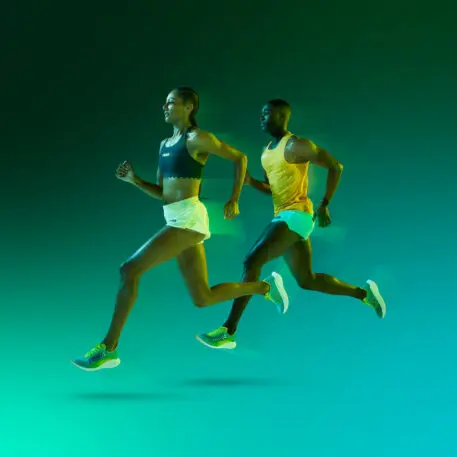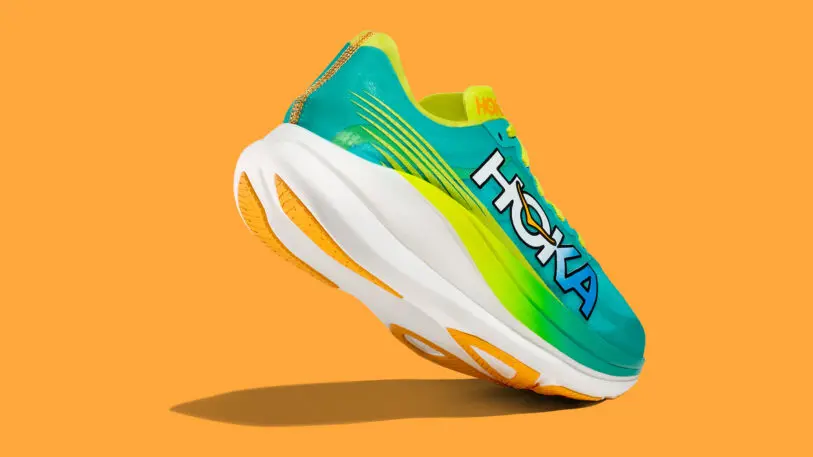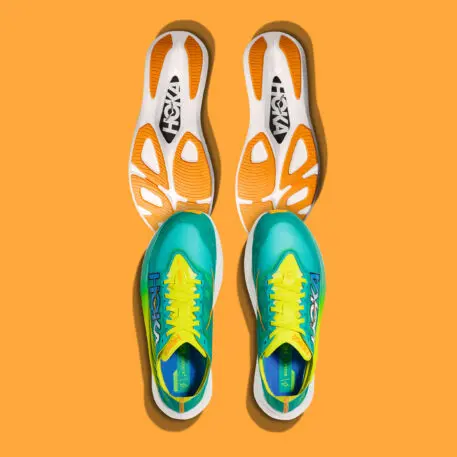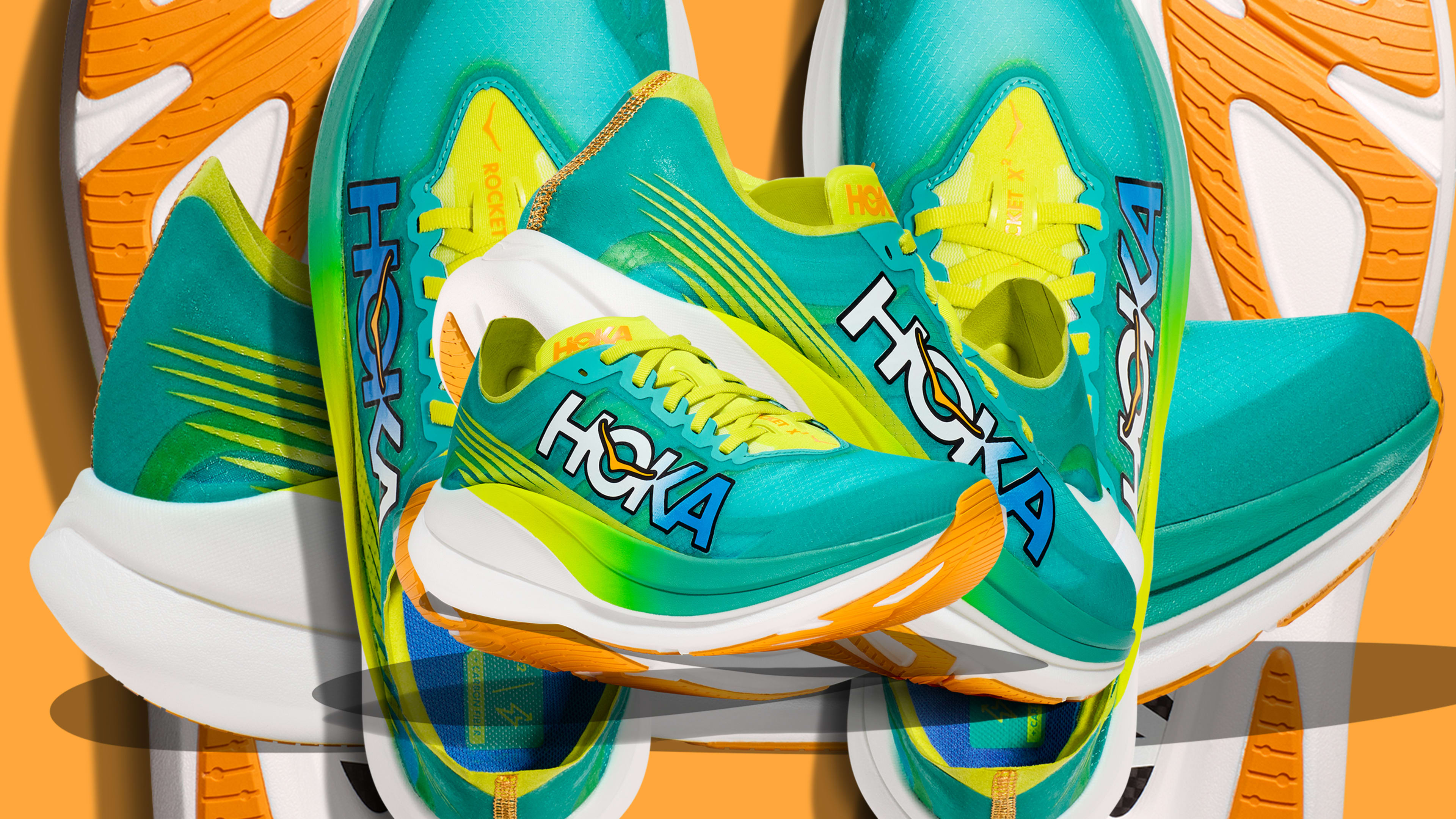In my teens, my doctor told me that I was flat-footed, which explained why my legs hurt so much after a run. The solution, he said, was to get highly cushioned sneakers to support my foot arch. At the time, though, the only ones I could find were ugly orthopedics designed to give geriatric wearers more stability.
Two decades later, everything has changed: Chunky sneakers are in. People are wearing them to the gym, at the park, and for racing through the airport. This is thanks, in part, to Hoka, a sneaker brand whose comically large midsole and candy-colored uppers have become wildly popular.

Hoka didn’t start as a lifestyle brand. When it launched in 2009, it catered specifically to marathoners. But in 2013, after it was acquired by Santa Barbara, California-based Deckers Brands (which also owns UGG and Teva), it quickly became clear that people of all walks of life enjoyed highly cushioned shoes. Hoka has developed a plethora of styles that appeal to nonathletes, including hiking boots and fashion collaborations with Moncler and Free People. This strategy has been good for business: Last year, Hoka topped $1 billion in global sales.
But Hoka wants to return to its roots in running. Today it unveils a new shoe, the Rocket X 2, which is designed for long-distance road racing. The launch is an opportunity for Hoka to reassert itself as a brand for competitive runners, allowing it to better compete with other top running brands, from giants like Nike and Adidas to more recent upstarts like On and Athletic Propulsion Labs (APL).
“It became clear that in addition to providing these everyday cushioning experiences, we can’t forget about the ‘tip of the spear’ racing product,” says Rebekah Broe, Hoka’s director of performance product. “We had to figure out how to leverage some of Hoka’s qualities for the most elite athletes at the fastest end of the spectrum.”

“Functionality Can Be Beautiful”
Hoka was founded by two French runners, Nicolas Mermoud and Jean-Luc Diard, who loved speeding across the hills of New Zealand. They wanted to create a shoe that would make it easier to run on steep downward slopes, and decided to name their nascent brand Hoka, the Maori word meaning “to soar.”
Mermoud and Diard were initially inspired by the orthopedic shoes I maligned in my youth. They created oversized midsoles that would absorb impact and reduce fatigue; they also incorporated a rounded sole that gives the runner a feeling of propulsion. At the time, the silhouette of the shoe looked unusual. But rather than disguise it, they leaned into its oddness and made the shoe stand out thanks to vibrant color palettes of saturated red, orange, blue, and green.
“From a design perspective, we’re driven by the idea that functionality can be beautiful,” Broe says. “We’re known for our big stacked heights, so let’s celebrate it. Let’s give it beautiful color, rather than trying to hide it.”
The original Hoka shoe was a hit with ultramarathoners. But 14 years later, Broe says there is new material science and physiological research that can help create an even more comfortable and efficient ride for elite runners. Hoka poured much of this research into the Rocket X 2.
For one thing, Hoka has developed a more nuanced perspective on cushioning. The brand’s signature oversized soles make for a more comfortable run, but in doing so, they also take pressure off your foot, so you’re no longer relying on your own physiology to drive your body forward. Stephanie Bruce and Wesley Kiptoo, professional distance runners who worked closely with Hoka on the Rocket X 2, pointed out that runners want to engage their feet and strengthen their muscles. So Broe’s team designed the Rocket X 2 with a slimmer sole. “Less cushioning gets your muscles, tendons, and ligaments to stay engaged,” she explains. “On some of our thickest soles, like the Bondi, you’re relying on your body a little less for mechanical assistance.”

At the same time, the shoe needs to help relieve fatigue. This is where cutting-edge materials came in. Broe’s team worked with scientists to develop a material that creates more energy return than anything in their current portfolio. They developed a foam made of PEBA (polyether block amide), a polymer that has optimal bounce. “The material compresses with each step, but then it returns more of that compression,” Broe explains. “It creates a bouncy sensation underfoot and prevents the foot from experiencing tiredness.”
Bruce and Kiptoo also expressed that they wanted their foot to feel secure and stable. While some shoes have an upper that sits on top of the midsole, the Rocket X 2 has a frame that wraps around the foot. “We give the analogy of sitting in a bucket seat,” Broe says. “It makes you feel cradled, so you and the shoe are acting as one.”

The Spectrum of Hoka Lovers
As Hoka’s customer base has grown, the brand’s challenge has been to create shoes that meet the needs of both ends of the spectrum, from people who enjoy a highly cushioned walk to athletes like Bruce and Kiptoo who run for hours a day.
Multibillion-dollar brands like Nike and Adidas have been built by appealing to both kinds of consumers. They create extensive collections of fashion-forward lifestyle sneakers, often in collaboration with other brands and celebrities. But they also have designers devoted to the needs of top athletes, crafting shoes they will wear into competition, including the Olympics and NBA games.
Hoka is following a similar playbook. Broe says that the brand is deploying Hoka’s signature sole so that it’s adapted to each use case. For casual wearers, like myself, who enjoy the foot support and stability of a thick sole, Hoka is focused on creating a sensation of cloud-like cushioning. And for runners, the focus is on creating a sense of forward propulsion.
We’ll have to wait and see whether Hoka’s strategy will allow the brand to achieve the scale of its enormous competitors. But what’s clear is that it has already changed the aesthetics of the sneaker world, transforming the thick, cushioned sole from an object of derision into a fun design element. “We embraced the things that make Hoka quirky and unique, and we played them up,” Broe says. “We celebrated the chunky sole and brought our customer along for the ride.”
Recognize your company's culture of innovation by applying to this year's Best Workplaces for Innovators Awards before the extended deadline, April 12.
